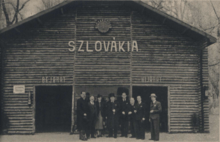Slovaks in Hungary
Slovaks in Hungary (Slovak: Maďarskí Slováci, Hungarian: magyarországi szlovákok) are the third largest minority in Hungary, after Romas and Germans. According to the Census in 2001, a total number of 17,692 people claimed themselves to be Slovaks in Hungary. The total number of people who can speak the Slovak language is 56,107.[1] According to the estimates of minority organisations, there are about 100,000-110,000 people with Slovak ancestry in Hungary. Hence, the estimated population of Slovaks in Hungary is ranging from 0.18% to 1.1% of the total population of Hungary.[1][2]
Maďarskí Slováci | |
|---|---|
 Slovak pavilion at the 1940 Budapest International Fair | |
| Total population | |
| 17,692[1] | |
| Regions with significant populations | |
| 7,267 | |
| 6,000 | |
| 3,174 | |
| 2,644 | |
| 2,581 | |
| 2,000 | |
| 1,500 | |
| Languages | |
| Hungarian, Slovak | |
| Religion | |
| Roman Catholicism | |
| Related ethnic groups | |
| Slovaks | |
.png)
History
The presence of the Slovak ethnicity in the territory of present-day Hungary dates back to the Middle Ages.[3][4] In the 9th-10th century, the Slavic-populated territories were part of the Great Moravia. Subsequently, in the 9th century these areas were included into the Principality of Hungary out of which the Kingdom of Hungary emerged in AD.1000. In the 16th century, after the Battle of Mohács during the Turkish wars, the Kingdom of Hungary was split into three parts and the Slovak-populated regions mostly became part of the Habsburg controlled Royal Hungary. After the Ottomans were defeated in the end of the 17th century, all Slovak-populated areas were included into the Habsburg Kingdom of Hungary. At that time, Slovaks mainly lived in the northern parts of the country, often referred to as Upper Hungary (today mostly Slovakia). In the 18th and 19th century, some Slovak migrants started to settle in other counties (in the northern parts of present-day Hungary) and developed strong mutual language contact with the Hungarians and later also settled in the some southern regions. Following a period of Slovak demand for autonomy within Habsburg Kingdom of Hungary, conflicts between Slovaks and Hungarians arose. According to the Treaty of Trianon from 1920, most of the Slovak-speaking territories of the pre-war Kingdom of Hungary were recognized as part of Czechoslovakia.[5] Some Slovaks, however, remained within the borders of post-Trianon Hungary. According to Austro-Hungarian data from 1900 there was 192,200 Slovaks in the territory of present-day Hungary (2.8% of total population).[6] According to the Hungarian census, 141,882 people spoke Slovak in 1920.[7] The Czechoslovak–Hungarian population exchange that took place after 1920 was repeated after World War II when about 73,000 Slovaks resettled from Hungary to Slovakia.[2]
See also
References
- "MINISTRY OF FOREIGN AFFAIRS BUDAPEST" (PDF). Mfa.gov.hu. Retrieved 10 January 2018.
- "European Commission". Ec.europa.eu. Archived from the original on 12 February 2012. Retrieved 10 January 2018.
- Ottov historický atlas - Slovensko, Zdroj poučenia, poznania a pochopenia našich dejín, Pavol Kršák, Vydavateľstvo: Ottovo nakladatelství. 2009. p. 75.
- "Ottov historický atlas - Slovensko". Martinus.sk. Retrieved 10 January 2018.
- Fawn, Rick; Hochman, Jiri (19 November 2009). "Historical Dictionary of the Czech State". Scarecrow Press. p. 263. Retrieved 10 January 2018 – via Google Books.
- "Ethnic Groups and Population Changes in Twentieth-Century Central-Eastern Europe". M.E. Sharpe. p. 335. Retrieved 10 January 2018 – via Google Books.
- Seton-Watson, Hugh (10 January 2018). "Eastern Europe Between the Wars, 1918-1941". CUP Archive. p. 431. Retrieved 10 January 2018 – via Google Books.